Exploring the Charm of Gemstone Engagement Rings
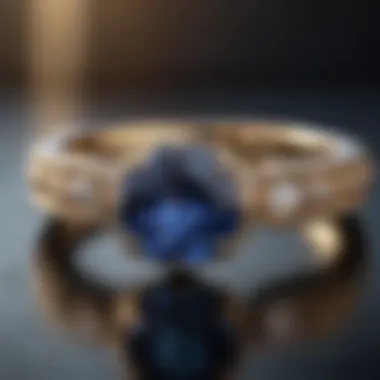

Intro
Engagement rings have long captivated hearts and minds, embodying a promise and deep connection between two people. However, in recent years, there's been an exciting shift toward gemstones beyond the traditional diamond. These vibrant stones often carry unique meanings and stories, allowing couples to express their individuality and sentiments in truly personal ways.
This article aims to explore the intricate world of engagement rings adorned with various gemstones, shedding light on their meanings, origins, and the practicalities of selecting the right stone to suit one's style and purpose. From exploring the historical significance of gemstones to understanding their properties, this guide serves as a valuable resource for gemstone enthusiasts, collectors, and anyone in the market for an engagement ring that reflects their one-of-a-kind love story.
Gemstone Overview
Definition and Origins
Gemstones are crystalline minerals that are prized for their beauty, durability, and rarity. Throughout history, different cultures have placed various meanings and values on these stones, each telling their own tale. Take sapphire, for instance; in ancient India, they were believed to bring protection and ensure wisdom, while in the Middle Ages in Europe, they were a symbol of divine favor.
The allure of gemstones can be traced back thousands of years, where civilizations like the Egyptians and the Greeks utilized them not just for adornment but also for talismanic properties. Each stone’s origins often dictate its character and the cultural narratives that accompany it.
Historical Significance
Historically, gemstones have been chosen for engagement rings not only for their aesthetic appeal but also for their symbolic meanings. For instance, ruby, the stone of passion, was believed to symbolize undying love while representing both strength and vitality.
Engagement rings with stones other than diamonds are gaining popularity, offering couples a path to express their unique narratives. The rise of custom-designed jewelry and the increasing preference for ethical sourcing have breathed new life into the engagement ring market, drawing more attention to colorful gemstones that resonate with personal stories.
"Choosing a gemstone is not just about aesthetics; it’s about telling your love story through color, texture, and meaning."
Gemstone Properties
Hardness and Durability
When selecting an engagement ring, one must consider the stone's hardness and durability. The Mohs scale of mineral hardness is commonly referenced to gauge how resistant a gemstone is to scratching.
- Diamond: 10 (the hardest of all)
- Ruby and Sapphire: 9
- Emerald: 7.5 to 8, but more susceptible due to inclusions
- Opal: 5.5 to 6.5, less durable than other choices
Understanding these properties can be crucial in choosing a stone that will withstand the wear and tear of everyday life.
Color and Clarity
Color and clarity are vital elements influencing a gemstone’s appeal. The depth of color can vary from stone to stone; deep blue sapphires are generally more sought after than lighter shades, while vivid greens in emeralds often command a higher price tag. Clarity plays a crucial role too, as higher clarity stones tend to flaunt their natural beauty more prominently.
Factors to consider include:
- Saturation: How pure is the stone's color?
- Hue: What is the primary color?
- Tone: How light or dark is the stone?
- Inclusions: Natural inclusions can add character or detract from clarity.
Learning about these aspects can greatly enhance one’s understanding of the stone and aid in making an informed purchase.
Prolusion to Engagement Rings with Stones
Engagement rings with stones are more than just beautiful ornaments. They're tokens of love, heritage, and individuality, holding profound meanings that vary across cultures and personal preferences. Selecting an engagement ring is often a monumental decision, one that deserves thoughtful consideration. This section sheds light on the significance of these rings, helping potential buyers understand what they represent beyond mere aesthetics.
Historical Context
The history of engagement rings is rich and varied, tracing back thousands of years. In ancient Egypt, rings made of braided reeds symbolized eternal love, reflecting the circular nature of the ring itself. The tradition of wearing rings to signify betrothal evolved significantly through the ages.
In Rome, the use of gold rings became a norm among the elite, with many believing that the vein in the ring finger led straight to the heart. This historical notion bridges romanticism with anatomy, reinforcing the deep connection between love and physical tokens. Additionally, the introduction of gemstones marked another turning point. During the Renaissance, high-profile engagements saw the use of ornate settings adorned with sapphires and rubies, adding color and meaning.
Throughout history, different cultures adapted this tradition, resulting in a fascinating tapestry of customs surrounding engagement rings. For instance, some regions still uphold the practice of using specific stones to convey traits like fidelity and prosperity.
Cultural Significance
Engagement rings are steeped in cultural significance, varying from region to region. In Western cultures, the diamond engagement ring reigns supreme, often seen as a symbol of purity and permanence. However, in other parts of the world, such as India and Japan, colored gemstones like sapphires and emeralds carry notable importance, often reflecting familial ties and spiritual meanings.
In many African cultures, the engagement ring serves not only as a promise between partners but as a way to signify the joining of two families, replete with deeper societal implications. The choice of stone can also communicate personal values; for example, a couple deeply invested in sustainability might opt for ethically sourced stones or lab-created alternatives.
Each gemstone tells a story, shaped by historical beliefs and personal narratives, allowing couples to express their unique journeys through their selections.
"The ring does not merely hold a gemstone; it encapsulates dreams, legacies, and the very essence of commitment."
As traditions continue to evolve, the engagement ring remains a powerful symbol of love and connection, proving its enduring allure in both contemporary and historical contexts.
Types of Gemstones in Engagement Rings
When it comes to engagement rings, the choice of gemstone is not just about sparkle—it's an expression of identity, tradition, and sentiment. Each stone brings with it a set of properties, cultural meanings, and practical considerations. In today’s jewelry market, understanding the different types of gemstones helps couples make informed decisions, combining aesthetics with emotional significance. The allure of these stones is tied intricately to personal preferences and the desire to select a ring that speaks to one’s soul.
Diamond
Color Grades
Color grading for diamonds is essential in determining their quality and value. Unlike a simple, clear-cut world, diamond color grades lie on a scale ranging from D (colorless) to Z (light yellow or brown). The most sought-after diamonds are those classified between D and F, presenting a pure hue, enabling brilliance to shine without distraction. Choosing a higher-grade diamond is popular not just for its aesthetic appeal, but it also holds high resale value. However, be mindful—while a D-grade diamond may prompt oohs and aahs, there are beautiful stones at the G or H level that maintain charm without breaking the bank.
Clarity and Cut
The clarity of a diamond reflects its purity, pinpointing imperfections that can range from minor flaws to significant inclusions. Graded from Flawless (no inclusions visible even under magnification) to Included (inclusions visible without magnification), clarity influences both beauty and price. Combined with the diamond cut, which refers to the angles and proportions affecting light performance, clarity becomes an integral part of a diamond’s narrative. A diamond with high clarity and a superb cut showcases brilliance. However, buyers should prioritize cut over clarity; a beautifully cut diamond can outshine others with higher clarity grades.
Symbolism of Diamonds
Diamonds are often referred to as a symbol of eternal love. They embody strength and resilience, said to last a lifetime—a fitting narrative for engagement. Many believe that choosing a diamond not only represents a love story but also embodies the promise of commitment. While modern couples may opt for various gemstones, the diamond remains firmly positioned in the collective consciousness as the quintessential choice for engagement rings. This cultural inertia can validate the preference for diamonds—not just a rock, but a narrative that speaks of hope and devotion.
Sapphires
Color Varieties
Sapphires aren’t just blue. They come in vibrant yellows, pinks, and even whites, each hue unlocking unique meanings and aesthetics. The classic blue sapphire symbolizes wisdom and nobility, making it a timeless choice, but the pink variety has gained popularity among those looking for a more romantic tone. Each color variety tells a story, and its brilliance can fit perfectly within the wearer's personality. However, while sapphires may appear resilient, buyers should ensure that they are indeed purchasing untreated stones, as treated sapphires may have significantly less value.
Cultural Beliefs
The cultural significance of sapphires spans various civilizations. Known as a stone of protection, it was believed to bring about serenity and wisdom. Royalty in different cultures have adorned themselves with sapphires, reflecting status and prestige. This cultural belief serves as an allure for many buyers. The symbolism may add a layer of depth when choosing sapphires, transforming a simple ring into a talisman that reflects centuries of tradition.
Hardness and Durability
One key characteristic of sapphires is their hardness; second only to diamonds, sapphires score a solid nine on the Mohs scale. This durability makes them a functional choice for everyday wear, a crucial factor for engagement rings. Women looking for a beautiful yet sturdy gemstone often consider this very aspect. Though sapphires are hard, they are susceptible to scratches if not cared for properly, requiring regular cleaning to maintain their luster.


Emeralds
Meaning of Green
Emeralds, distinguished by their lush green hue, symbolize rebirth and love—qualities that resonate deeply in relationships. Their vivid color evokes feelings of tranquility, growth, and harmony. The appeal of emeralds is heightened by these positive connotations; however, their color can vary across shades, which is important when selecting the perfect gemstone. Couples drawn to sincerity and authenticity may find that emeralds speak a language of connection that’s profound yet elegant.
Care and Maintenance
Emeralds require a delicate touch. Their unique inclusions, known as “jardin,” often influence their durability and aesthetic charm. Proper maintenance involves gentle cleaning with lukewarm water and mild soap, avoiding ultrasonic cleaners or harsh chemicals that might cause damage. As such, buyers should be aware that emeralds may require more care than their diamond counterparts. This aspect may deter some buyers who may prefer a low-maintenance gem.
Historical Usage
Throughout history, emeralds have adorned the crowns of emperors and were favored by figures like Cleopatra, who believed in their magical properties. Their historical significance enhances their allure for those looking to make a bold statement with an engagement ring. However, it’s essential to note the high value placed upon high-quality emeralds, which can significantly vary depending on clarity and color saturation. This historical depth allows buyers to enjoy a piece of legacy wrapped up in their choice.
Rubies
Passion and Love Symbolism
Rubies are often associated with passion and love, their deep red hue exuding an intensity that speaks directly to the heart. Many cultures have revered rubies as a symbol of devotion, making them a powerful choice for engagement rings. However, while their allure is compelling, it’s wise for buyers to consider personal values and preferences, as not everyone wishes to convey passion through a ruby. This notion may lead to a more personalized understanding of what each gem represents within a relationship.
Value and Rarity
The rarity of rubies is another key factor influencing their allure. High-quality rubies can surpass even diamonds in value, capturing the attention of serious collectors. However, the mid-range rubies often carry much lower price tags—understanding their value spectrum is key for potential buyers. It’s vital for couples to balance the emotional aspect of choice with the financial implications without losing sight of their desired style.
Gemstone Treatments
Many rubies undergo treatments for enhancement, making it critical for buyers to inquire about the specifics of their chosen stone. Treatments like heat treatment are commonly used to improve color and clarity, leading to stones that appear more brilliant. Yet, untreated rubies possess a unique value that discerning buyers appreciate. Educating oneself on these treatments may protect buyers from overpaying for stones without clarity on their treatment history.
Alternative Stones
Moissanite
Moissanite has emerged as a popular alternative to diamonds in recent years. Known for its exceptional brilliance and fire, this lab-created gemstone offers an eco-friendly choice that appeals to environmentally conscious couples. With a hardness rating of 9.25, moissanite is also quite durable, making it suitable for everyday wear. However, buyers should be cautious as it may not carry the same emotional weight or status that natural diamonds symbolize in society.
Lab-Created Stones
The rise of lab-created stones provides a budget-friendly alternative without compromising quality. These stones can mimic the brilliance of natural gemstones and resonate with buyers keen on ethical sourcing. However, some couples might find lab-created gemstones less appealing due to a perceived lack of authenticity compared to their naturally sourced counterparts. Balancing budget with emotional significance is crucial in this context.
Unconventional Choices
Lastly, unconventional choices are gaining traction among couples looking to break away from tradition. From unique options like opals that shift colors to the captivating allure of alexandrite, these stones tell a story that is distinctly individualistic. While they can express personal style, buyers should consider potential wearability and maintenance of these uncommon stones. The choice to go unconventional can reflect a couple's story, making it uniquely theirs.
Exploring diverse gemstone options can unveil new possibilities for expressing love and commitment. By understanding the properties, meanings, and maintenance of each stone—and by weighing emotional significance against practical considerations—couples can embark on a meaningful journey toward selecting their perfect engagement ring.
Choosing the Right Stone
Choosing the right stone for an engagement ring is a monumental decision that goes beyond mere aesthetics. It’s about personal expression, emotional significance, and practical considerations. Each gemstone comes with its own story, making the selection process an intricate part of personal commitment.
When it comes down to it, the stone often symbolizes the relationship itself — its uniqueness, durability, and beauty. It becomes a part of the narrative shared between partners, reflecting their journey, shared values, and plans for the future. Getting this choice right is tied closely to personal preferences, budgetary constraints, and insights from knowledgeable experts.
Personal Preferences
Color Preferences
Colors capture emotion. When choosing a gemstone, the color preference plays a crucial role in its selection. People are drawn to specific hues, and this attraction often resonates deeply with their personalities and styles.
Some choose the classic white brilliance of diamonds, while others may lean towards the rich blue of sapphires or the deep green of emeralds. This specific aspect of color preferences isn’t just about visual appeal; it’s also an emotional connection that enhances the overall experience of wearing the ring.
A key characteristic of color is its versatility. Depending on one's skin tone, what looks stunning on one person may not have the same effect on another. Selecting a color that complements the wearer’s features can elevate the beauty of the ring. However, certain colors may also influence how one feels wearing their ring, as different hues evoke different emotions.
Symbolic Meaning
The symbolic meaning tied to gemstones cannot be understated. Each stone carries a history of beliefs and interpretations that enhance personal significance. For instance, sapphires are often associated with wisdom and loyalty, while rubies exemplify passion and love.
This deeply engrained moving narrative featuring symbolisms makes it a popular approach in ring selection. A unique feature is that couples can intentionally choose a stone that reflects their love story or their aspirations together; this has advantages and disadvantages. While deeply meaningful, it can also complicate decisions if both partners have differing opinions on which symbolism resonates most.
Lifestyle Considerations
Finally, considering one's lifestyle when choosing a stone is paramount. Stones like diamonds may be deemed more suitable for an active lifestyle due to their hardness, while softer stones like opals or pearls might better fit someone who prefers a more understated or less rigorous daily routine.
The intersection of lifestyle with stone choice is another critical characteristic. This consideration doesn't only safeguard the integrity of the piece but also ensures that the ring is something that can be worn every day without fear of damage. However, this unique feature can limit choices, as durability must often be weighed against aesthetic allure.
Budgetary Constraints
Setting a Budget
Establishing a budget prior to shopping helps guide the decision-making process. This not only prevents overspending but also narrows down the options, making it easier to explore the breadth of choices within a specific price range. Many buyers are often surprised to find that they can discover beautiful rings within their budget without having to compromise on quality.
The fundamental aspect of setting a budget creates a structured framework. This is particularly devine for those who may be uncertain about how much to spend. By setting a threshold, it empowers buyers to make informed decisions while navigating enticing yet potentially overwhelming options.
Value Retention
Another critical aspect is value retention. Some gemstones, like diamonds, tend to maintain their value well over time. Understanding the investment potential of a stone can enhance the buying process as couples look ahead toward the future.
A key characteristic here is knowledge of market trends, which can influence the selected stone’s long-term value. However, some stones may have lower resale value, which can lead to regret if bad choices are made. Knowing this can mean the difference between embracing a sentimental piece or investing in a financial asset.
Financing Options
Financing options can bridge the gap between aspiration and actuality when it comes to choosing a ring. Many jewelers offer different payment plans or credit options that can help make higher-end choices more attainable.
These plans can relieve financial stress, allowing couples to select a meaningful stone without the weight of an immediate full payment burden hanging over their heads. However, it’s vital to review the terms and conditions carefully; caveats and high-interest rates can transform a thoughtful purchase into a regrettable one.
Expert Guidance
Consulting Jewelers
When in doubt, consulting jewelers can provide clarity. Savvy jewelers not only share knowledge about different stones but also offer insights into trends and available options suited to one’s individual needs chosen stone.
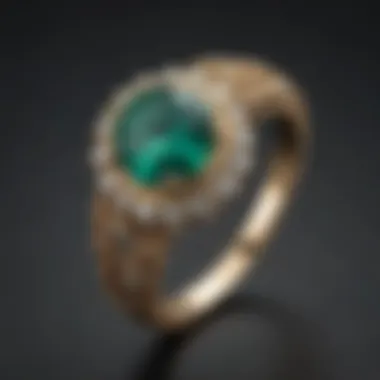
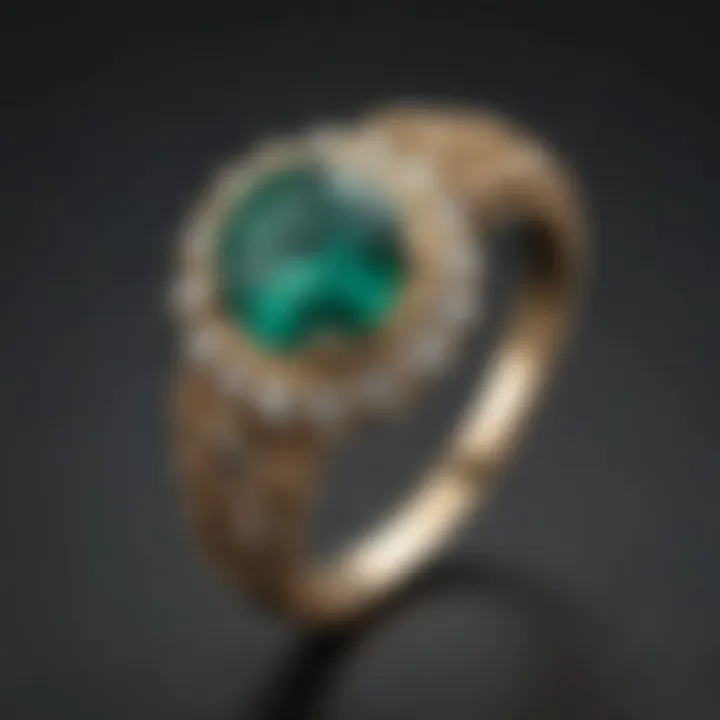
A unique feature of their counsel is the blend of expertise and personal experience since they've seen countless clients at various stages of the buying process. This can help navigate emotional and practical aspects of buying an engagement ring, enhancing the decision-making process.
Understanding Gemology
Delving into gemology creates a comprehensive understanding of what makes a stone desirable. This insight allows buyers to appreciate a stone’s qualities beyond surface beauty, recognizing nuances like clarity, cut, and origin, which all affect desirability and value.
Understanding gemology can flourish awareness of unique traits, helping potential buyers make informed choices. However, armed with too much information, people can feel overwhelmed rather than empowered.
Certifications and Appraisals
Lastly, certifications and appraisals come into play as assurance of quality. They can confirm authenticity and provide an unbiased assessment of the stone's value. This is rather beneficial, especially for high-end goods or rare stones.
While possessing a certification instills confidence, it is also crucial to rely on the appraiser's credibility. The unique blend of trust and verification makes this a key characteristic in securing a worthwhile purchase that aligns with both emotional and financial investment.
Choosing the right stone for an engagement ring becomes an intricate dance of personal touch, practical details, and expert insight. By considering color preferences, symbolic meanings, lifestyle elements, budgetary constraints, and professional guidance, couples can make informed choices in relation to lasting emotional impact in their engagement journey.
The Craft of Engagement Ring Design
When it comes to engagement rings, design plays a pivotal role in not only showcasing the beauty of the chosen gemstone, but also in enveloping a significant personal narrative. This is where the craft of engagement ring design takes center stage, intertwining artistry, practicality, and emotional significance into every piece. A well-designed ring not only reflects style but also carries the weight of a lifelong commitment.
Metal Options
The choice of metal in an engagement ring isn't just about aesthetics; it serves as the foundation for the entire piece.
Gold
Gold has long held a coveted place in jewelry making. Available in various hues—yellow, white, and rose—it offers versatility. The striking aspect of gold lies in its malleability and luster, making it ideal for intricate designs. Gold's historical significance is also noteworthy, as it's often used in symbolic representations of love and promise. However, buyers should be aware of karat values, which indicate the purity of the gold. The unique feature of gold is its warm glow that many find enchanting. But one must also consider that gold can scratch or tarnish over time, requiring meticulous upkeep.
Platinum
Platinum, a noble metal, has recently gained traction in the world of engagement rings. One of its key characteristics is its incredible durability; it is resistant to wear and tear, ensuring that the ring remains beautiful over a lifetime. Its unique feature is the natural white sheen that requires no plating, a significant advantage for those seeking low-maintenance options. Nonetheless, platinum often comes with a steeper price tag, which can be a con for budget-conscious couples.
Alternatives: Silver and Rose Gold
When discussing engagement ring metals, silver and rose gold often come up as alternatives. The allure of these metals lies in their unique aesthetics and affordability. Silver, while not as durable as gold or platinum, has a bright finish that many adore. However, it's prone to tarnishing, which can be a drawback. On the other hand, rose gold has surged in popularity thanks to its romantic hue, often seen as a warmer option compared to traditional choices. Its unique blend of metals gives it a specific pinkish tint, making it distinctively attractive. Yet, it may not hold as much long-term value compared to its gold and platinum counterparts.
Settings and Styles
The setting of an engagement ring is as vital as the stone it holds, shaping the entire look and protecting the gem at the same time.
Solitaire
The solitaire setting stands alone in its classic elegance. A hallmark of simplicity, this design focuses solely on one stone, emphasizing its beauty without distractions. This choice is beneficial for those who prefer timelessness and wish to showcase the gemstone as the focal point. However, the limitation here is that it may not suit everyone's taste, particularly those who enjoy more elaborate designs.
Three-Stone
The three-stone setting represents the past, present, and future of a couple’s journey. This symbolic aspect is what draws many to choose this style. Typically, a larger center stone is flanked by two smaller stones, often of the same type but occasionally different gems are used for contrast. It combines not just beauty but significant meaning, making it a great choice for those sentimental in nature. On the downside, the design can make the ring bulkier, which some may find uncomfortable.
Vintage and Custom Designs
Vintage and custom designs offer a personal touch that speaks volumes about individual style and preferences. Their key characteristic lies in the uniqueness they bring; no two pieces are identical, allowing for personalization that mass-produced designs simply can't match. This route encourages exploration of individual stories and desires, transforming rings into treasured heirlooms. However, the process can be time-consuming and sometimes pricier due to the craft involved, presenting tangible challenges for some buyers.
"The perfect ring doesn't just symbolize a commitment; it encapsulates the essence of shared love and memories."
Each component of design, from metal to style, contributes markedly to the overall allure of engagement rings, allowing couples to express their values and aesthetics distinctly.
Care and Maintenance of Gemstone Rings
Taking care of gemstone rings might seem like a minor detail, but it plays a vital role in preserving the ring's beauty and longevity. These rings are not just decorative pieces; they often carry substantial emotional value and monetary investment. Neglecting their maintenance can lead to a host of problems, including scratches, tarnishing, and even lost gemstones. Therefore, understanding the nuances of proper care becomes paramount for any gem lover.
Regular Cleaning Tips
Home Cleaning Solutions
When it comes to maintaining the shine of gemstone rings, home cleaning solutions are very popular. They are typically cost-effective and easily accessible. A mixture of mild soap and warm water can do wonders, allowing you to clean your rings simply with a soft cloth or a toothbrush with soft bristles. One of the main benefits of home solutions is that they let you be in control of the cleaning process, making it a straightforward task you can perform as often as needed.
However, it’s crucial to avoid harsh scrubbing, especially on sensitive stones like pearls or opals, as they can be damaged easily. The ease of use and the gentle nature of the cleaning solution can help maintain your ring’s luster without the need for professional assistance.
Professional Services
Engaging professional services for cleaning engagement rings can be a game-changer, particularly if the ring features intricate designs or multiple stones. Jewelers have specialized tools and equipment that safely cleanse without causing any harm. Regular professional cleanings can also often include checks for loose stones or wear on the setting, something that might go unnoticed in a casual home cleaning session.
The primary downside here is the cost involved and the inconvenience of having to visit a jeweler. Nonetheless, entrusting your beloved ring with a professional ensures it receives careful treatment that home methods cannot guarantee.
Frequency of Cleaning
How often should you clean your ring? That’s a question many ask. The answer mostly depends on lifestyle factors such as how often the ring is worn and the types of activities one engages in. For example, if you're someone who works with your hands or engages in activities prone to dirt or chemical exposure, you might want to clean your ring more frequently—perhaps every week or two.
Alternatively, if it's reserved for special occasions, a once-a month cleaning could suffice. Regular attention not only maintains aesthetics but also circumvents larger issues down the line due to neglect. Taking the time for frequent cleaning can keep your gemstone ring looking as radiant as the day you acquired it.
Preventing Damage
Safe Storage Methods
Storing your gemstone rings properly is as crucial as regular cleaning. A safe storage method, such as using a soft-lined jewelry box, prevents scratching and tangling, especially when rings are not being worn. It’s also wise to keep gemstones separated to avoid friction between them, which can lead to expensive damage.
Keeping your ring stored in a cool, dry place further adds another protective layer against humidity and temperature extremes. Proper storage isn’t just about avoiding scratches; it can also help in preserving the ring's inherent value for years to come.
Avoiding Harsh Chemicals
Harsh chemicals can wreak havoc on the integrity of both the ring and its stones. Many household cleaning agents contain acids or compounds that may corrode or tarnish certain gemstones or metals. For instance, ammonia or bleach can damage delicate stones like turquoise or malachite.
A wise approach to avoid chemical damage is to remove your rings before engaging in household chores or applying beauty products. Understanding that prevention is key makes a significant difference in maintaining the ring's original allure.
Understanding Gemstone Vulnerabilities
Every gemstone has its unique set of vulnerabilities that can impact its beauty and durability. Some stones like sapphires, while hard, can still be susceptible to scratches and chips. Understanding these vulnerabilities allows for tailored care specific to each gemstone's needs. For example, softer stones like opals require more cautious handling and storage due to their relative fragility.
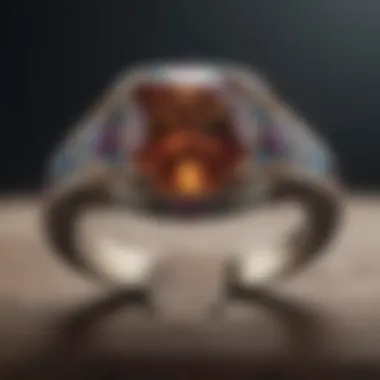
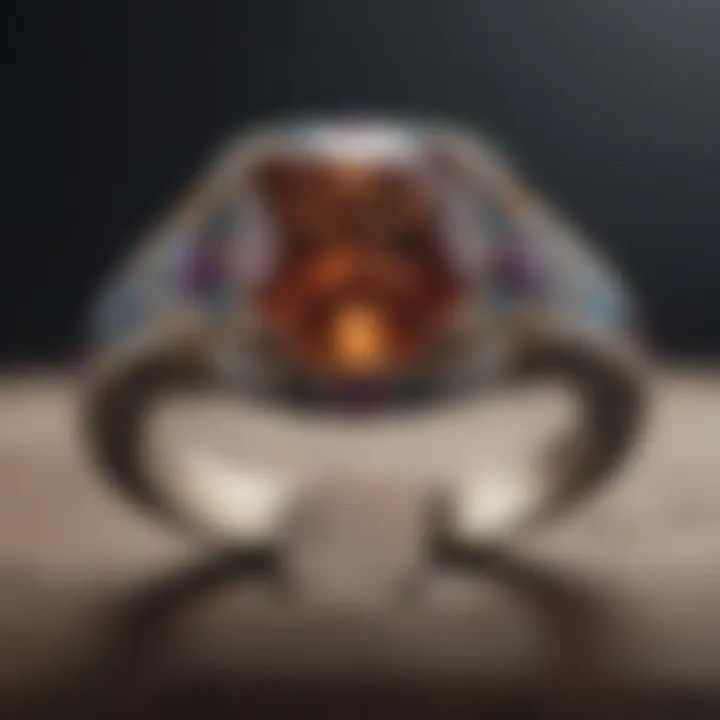
Being informed about your gemstone's particular weaknesses empowers you to take proactive steps in its maintenance. For instance, wearing an opal ring during heavy activity might not be advisable, translating to a need for mindfulness in both wearing and caring for it.
"Taking good care of a gemstone ring is not just about preserving the visuals; it's about honoring the emotional narratives they carry."
Navigating the Purchase Process
When it comes to picking the right engagement ring with a stone, navigation through the purchasing maze plays a crucial role. This journey isn’t just about picking a shiny rock; it encompasses understanding where to buy, being aware of return policies, and ensuring you get what you are paying for. A well-thought-out purchasing process will empower buyers to make informed choices and avoid those pesky buyer's remorse scenarios later on.
Where to Buy
Local Jewelers
Local jewelers hold a prominent place in the buying landscape. These small, often family-owned shops offer a distinct charm, bridging the gap between tradition and personalized service. One key characteristic here is the customizability; you can often work directly with the jeweler to create something that truly reflects your vision.
Commonly, local jewelers know their clientele and develop relationships that entail trust. They can provide insights into the stone's authenticity and ethical sourcing practices typical of larger chains. However, a downside can be the limited inventory they might have compared to big retailers. The selection could feel like it’s lacking at times.
- Advantages:
- Disadvantages:
- Personalized service
- Opportunities for custom designs
- Knowledgeable staff
- Smaller selection
- Potentially higher pricing depending on the shop
Online Retailers
The rise of digital platforms has made online retailers a significant player in the stone engagement ring market. With the click of a button, you can browse an expansive variety of stones from the comfort of your couch. This convenience allows buyers to easily compare prices and features across various options. One notable aspect is customer reviews; these can serve as a guide to making a well-rounded decision.
However, the downside lies in the inability to physically inspect the ring before purchase, which can lead to discrepancies between expectation and reality. Additionally, the return policies for online retailers can be a minefield, making it incredibly essential to read the fine print before committing to a buy.
- Advantages:
- Disadvantages:
- Extensive variety of choices
- Ability to compare prices easily
- Customer reviews available
- Can't physically inspect the piece before buying
- Potential return policy complications
Custom Jewelers
Custom jewelers offer a unique avenue for those looking to craft a truly one-of-a-kind piece. Working with artisans who specialize in bespoke designs, buyers can merge their ideas with expert craftsmanship. This market has expanded as more couples desire personal touches in their engagement rings.
Instead of mass-produced designs, custom jewelers focus on meeting specific client demands. Yet, this luxury does come with an increased price tag and maybe a long wait, depending on the craftsmanship required. Sometimes, the process can also feel intimidating for those who lack confidence in their design knowledge.
- Advantages:
- Disadvantages:
- Tailored designs that reflect personal tastes
- Unique craftsmanship
- Ability to communicate ideas with the jeweler directly
- Often higher cost due to custom work
- Long wait times for creation
Understanding Return Policies
Importance of Policies
When you buy an engagement ring, understanding the return policy is vital. Policies serve as a safety net. They outline how and when you can return or exchange a ring if it doesn’t meet your expectations or match the description. Knowing these policies can prevent frustration and financial loss down the line. A generous return policy can also indicate the retailer's confidence in their product.
- Advantages:
- Disadvantages:
- Security in case of mistakes or discontent
- Builds trust in the retailer
- Some retailers have very strict rules
Cancellation Terms
Life can throw curveballs, and sometimes you might need to cancel that ring order. Cancellation terms dictate how quickly you can pull the plug on your purchase and what kind of refund you might expect. This aspect is particularly important if you’re navigating financial or relational uncertainties.
- Advantages:
- Disadvantages:
- Allows buyers to change their minds without major loss
- Some retailers may have fees for cancellations
Exchange Conditions
Finally, let’s touch on the all-important exchange conditions. If the ring doesn’t fit or isn’t quite how you envisioned it, exchange conditions outline your options for swapping it out for something better. A flexible exchange policy can offer peace of mind and encourages you to feel comfortable about your investment. Still, it's important to note that some retailers may impose conditions that might complicate the process, such as timeframe restrictions or needing receipts.
- Advantages:
- Disadvantages:
- Flexibility if the original choice doesn't meet expectations
- Might have time constraints that don’t suit everyone
By carefully maneuvering through these aspects, buyers can cultivate a fulfilling experience in the world of engagement rings, enriching their journey with thoughtful choices.
Closure
The world of engagement rings adorned with stones captures not just the eye but also the heart. In today's society, where personalization and individuality hold immense value, the choice of an engagement ring extends beyond aesthetics. Each gemstone holds its unique story and significance, creating layers of meaning that can resonate deeply with its wearer.
The Lasting Impact of a Thoughtful Choice
Choosing the right stone for an engagement ring is about making a statement. The stone symbolizes love, commitment, and the journey ahead. For instance, an emerald might reflect a desire for growth and renewal, while a sapphire could express faithfulness. These considerations highlight the substantial emotional weight behind the decision. A thoughtful choice resonates long after the ring is placed on the finger, serving as a daily reminder of promises made and memories to be built.
People often overlook the notion that a ring can become a family heirloom. Selecting a gemstone with a rich background or cultural significance adds to its allure. Imagine passing down a ruby that signifies passion — generations will admire its beauty and the stories entwined with it. Therefore, individuals should take a moment to ponder on their selection, ensuring it reflects personal values and narratives.
Encouragement to Explore Varieties
In a market saturated with diamonds, venturing into the lesser-known realms of gemstones can be a rewarding experience. Not only does it provide uniqueness to one's engagement ring, but it also opens doors to colorful expressions of individuality.
Encouraging exploration means stepping outside of conventional norms. Consider the raw vibrancy of a citrine or the calming essence of an aquamarine. These choices might just spark conversations and admiration from onlookers. The diversity of options is staggering; one can find stones that resonate with personal beliefs or innovative designs that stand out.
- Explore unconventional choices like:
- Morganite: Symbolizing compassion.
- Tanzanite: A rarity that showcases elegance.
- Tourmaline: Known for its wide range of hues, each carrying its story.
Venturing into this all-encompassing world of gemstones doesn't only end at rings; it extends to pendants, earrings, or even bracelets. Each piece tells a story, interweaving experiences with personal history.
"Stay curious and adventurous in your search, for the right choice is not just a reflection of current trends but a timeless emblem of love and commitment."



